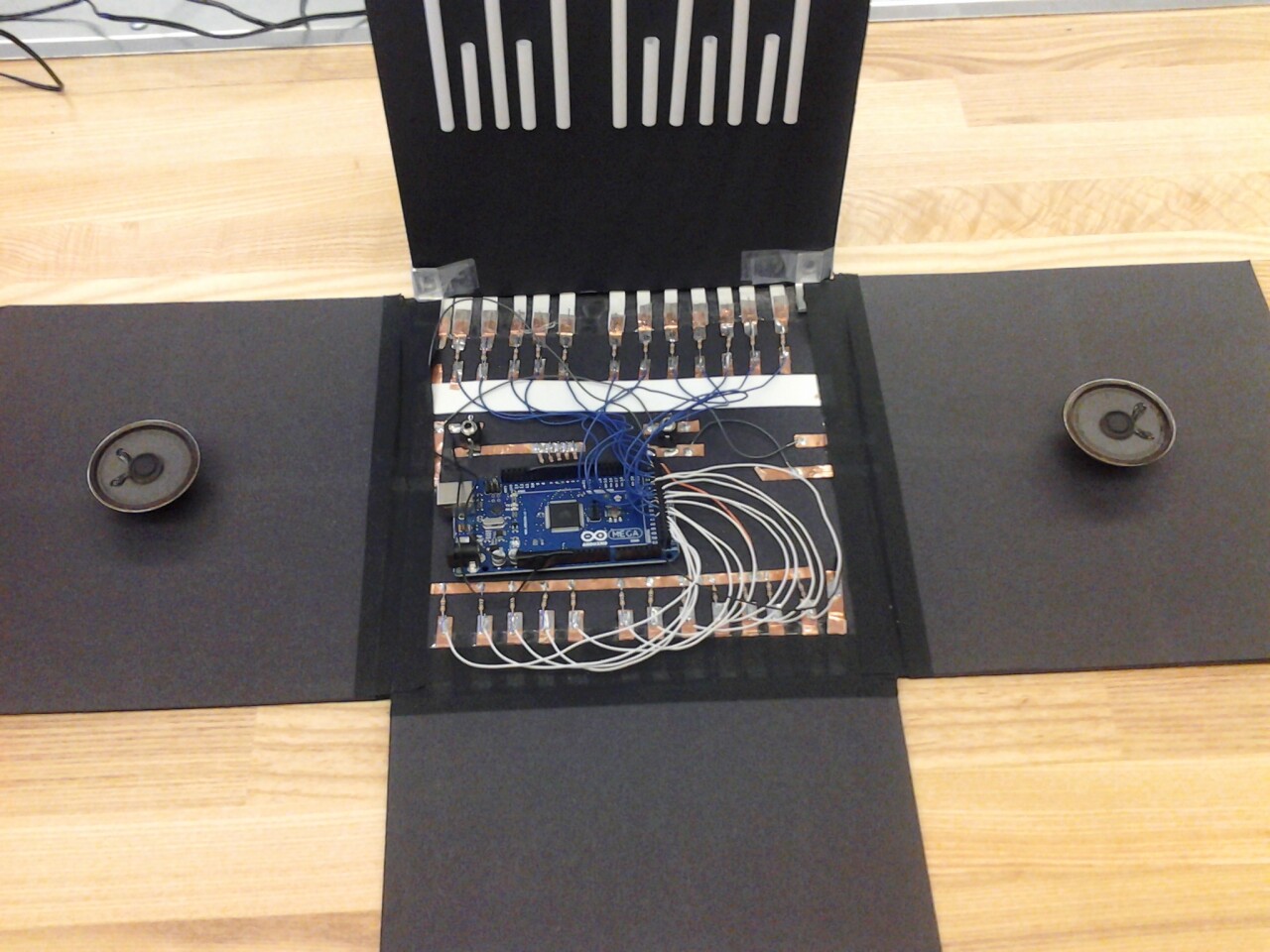Last year, Portugal's Catarina Mota was part of a New York hackerspace team that created a toy piano made from Jell-O (and some electronics) for a competition in Brooklyn, NY. Being a lover of mixing electronics with low-tech materials like fabric and paper, she has now created a paper box that opens up to reveal a 12-key touch piano/synthesizer sporting some cool LED light action. The Piano Box is built around an Arduino Mega board running the CapSense and Tone libraries, and features twin speakers, capacitive keys made from paper-covered copper tape, and some custom code that's available for free download to allow anyone to make their own paper synth.
After discovering that Jell-O and fruit were conductive, a small group of NYC Resistor members (Mota, Ranjit Bhatnagar, Mimi Hui and Astrida Valigorsky) embedded each of a number of food-based keys with its own food-safe silver pin, connected these up to an Arduino microcontroller and then used a metal utensil, gloves with conductive thread or even bare hands (so long as one hand touched the piano case and a key at the same time) to play the instrument. Versions of the prize-winning Resistor JelTone have been displayed and eaten at a number of exhibitions and festivals since first being created for the Jello Mold Competition at the Gowanus Studio Space in Brooklyn.
Mota told us that, even though the JelTone is polyphonic, requiring two hands or conductive materials to produce notes was less than ideal. While thinking about remaking the project in a new medium, fellow maker Will Byrd mentioned that creating musical instruments was the focus of classes he was teaching at Indiana University, with a few students looking into finding simple ways to create polyphonic instruments using Arduino.

"So, after some online research, Will and I sat one night and wrote the code for the Piano Box, which was greatly facilitated by the use of the CapSense and Tone libraries (which are doing all the hard work of reading the capacitive sensors and generating the tones)," the co-founder of the openMaterials research group, Lisbon's altLab hackerspace and the fabriCulture project said. "After that I made the physical structure."
Mota used copper tape topped by paper for each of the touch sensors/keys, but says that any conductive material should work. Each sensor was connected to the Arduino Mega microcontroller, and in turn mapped to LED lights. The board was then hooked up to the speakers. The Piano Box makes use of five of the six available hardware timers to allow up to five tones to be played simultaneously.
"The speakers are just outputting pre-defined tones, which are generated as a square-wave at a frequency specified by the Tone library running on the Arduino," she explained. "In reality, the two speakers you see on the sides aren't necessary, since the little amplifier comes with a pretty decent speaker. I added them just for symmetry ... One thing I should have done, but haven't got around to yet, is to design and make resonating boxes out of paper – this would hopefully increase the sound quality."
"Since it's a one-octave toy piano there aren't many melodies that can be played on it and I'm not a musician myself, but in theory you could make a version with more keys."
Should you be inspired to build your own version, project materials are not going to break the bank and all the necessary code is freely available. Mota told us that she used copper tape, resistors, LEDs, paper and drinking straws. There's also a small amplifier and a pair of speakers. The most expensive purchase was the Arduino Mega and while there are cheaper ways to complete the build, beginners might find themselves struggling.
The project has attracted a lot of attention since first appearing online, and Mota has been asked whether a kit build is going to be made available.
She says not, explaining that "for me the appeal of this project is that it's handmade using code, electronics and crafts techniques – if someone else makes their own it'll be different from mine and that's what makes it interesting."
Source: Catarina Mota








